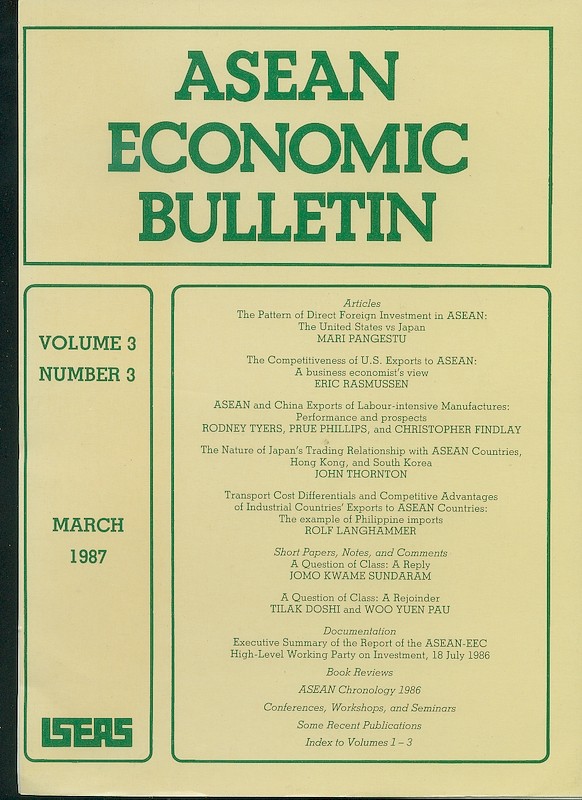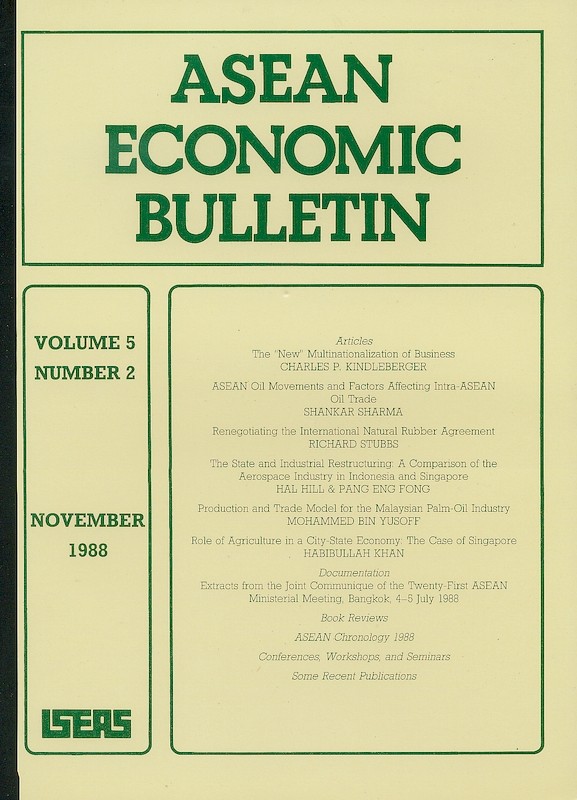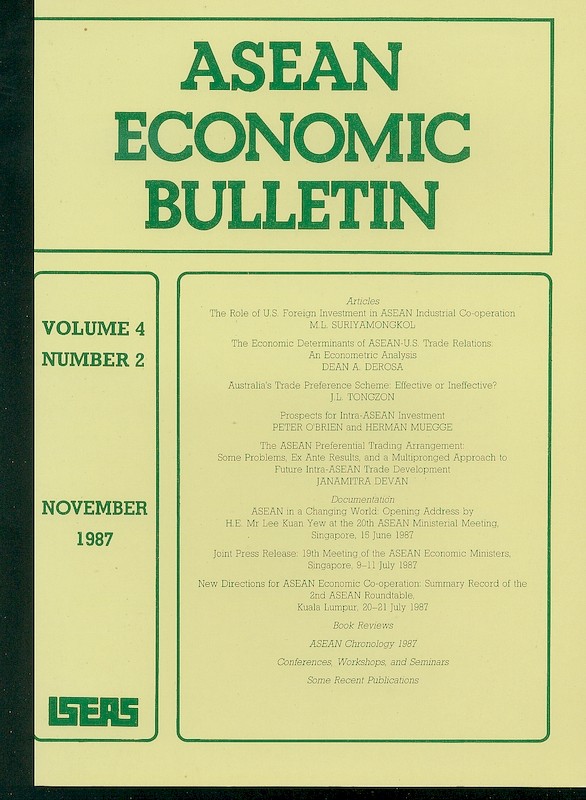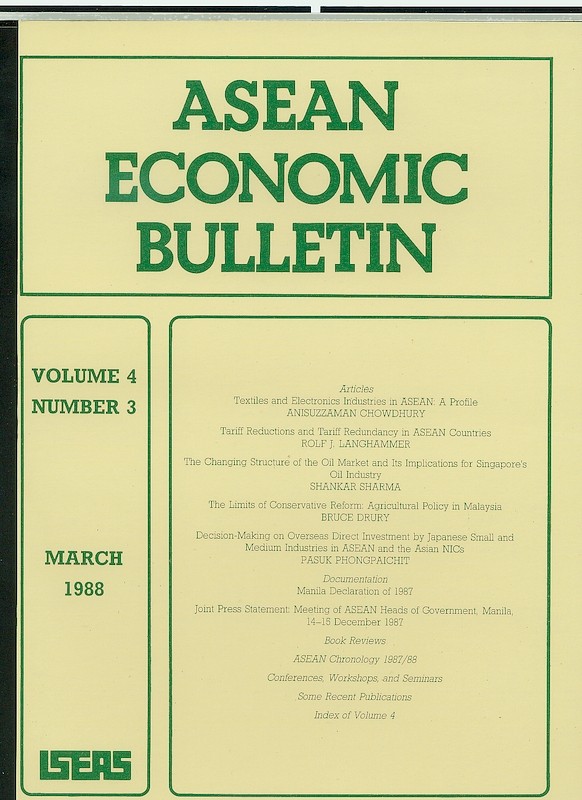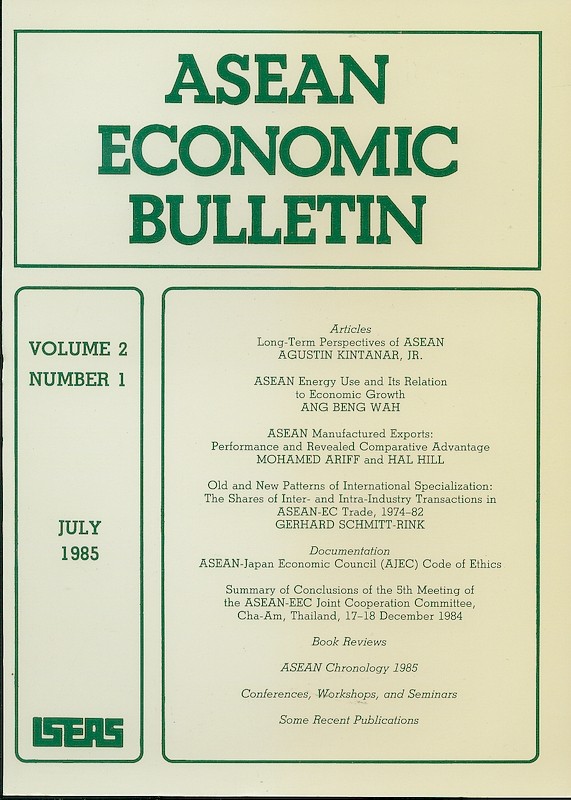ASEAN Economic Bulletin Vol. 5/1 (Jul 1988)
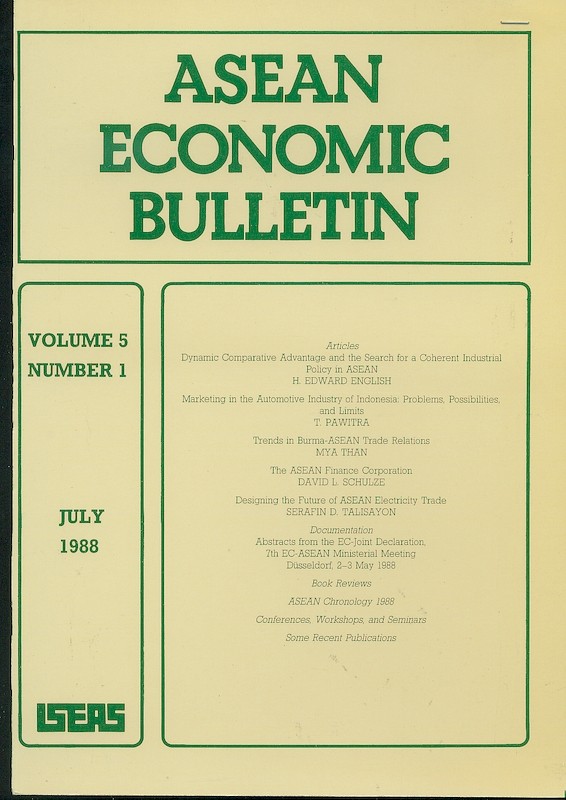
Date of publication:
July 1988
Number of pages:
112
Code:
AE5/1
Contents
-
Preliminary pages
- ARTICLES
-
Dynamic Comparative Advantage and the Search for a Coherent Industrial Policy in ASEAN, by H Edward English, author see abstractThe linkages between industrial policy and trade policy are explored in this article. The experience of various developed and developing countries is cited, with particular emphasis upon ASEAN. The importance of a trade policy that enables industrial sectors to respond to changing comparative advantages is stressed and proposals are made ensuring better means of identifying the bases of comparative advantages in developing countries, using more homogeneous classes of factor endowments not only labour and capital generally, but human capital, physical capital, and information-based endowments which can help to identify the probable evolution of industry structure in developing countries. If the rule of industrial policy is to be coherent, it is argued that it should be complementary to trade policy, assisting adjustment and compensating for market failures which impede outward-oriented development strategy.
-
Marketing in the Automotive Industry of Indonesia: Problems, Possibilities, and Limits, by T Pawitra, author see abstractThe marketing dimension is as important as production and finance in the industrialization process. It is a misapprehension to assume that marketing is a self-adjusting mechanism that alters itself to changes in production. Marketing acts as a catalyst to a successful industrialization of automobiles if the exchange process is being developed actively. In Indonesia one has to analyze carefully the problems, possibilities and limits of marketing within the prevailing marketing environment. Although the government attempts to create the necessary conditions to commence with a healthy industrialization programme, there are still a host of problems to be surmounted, such as the large number of brands, local content and the limited domestic market. Short-run advantages caused by the currency realignment open the opportunity for exports. But in the long-run the vehicles must be produced efficiently and export incentives should be introduced to maintain a competitive edge in the export markets. Rationalization of brands through holding companies and standardization of components seems inevitable to achieve the economies of scale. Marketing faces serious constraints due to external and internal factors, demanding a high standard of professionalism for those involved. The integrated strategic marketing concept could be considered in gaining and maintaining a competitive advantage in the national and international markets.
-
Trends in Burma-ASEAN Trade Relations, by Mya Than, author see abstractTrade relations between Burma and its ASEAN neighbours have existed since the earliest days of Burma's history. Trade has been growing rapidly during the last twelve years although the level of official trade, by international standards, is very low. This generally low level of trade may be attributed to a complex of factors in the contemporary history and political economy of Burma and ASEAN countries which have influenced the degree of openness of their economies and thus to trade. This study explores and analyses the trade relations between ASEAN countries and Burma. It raises the issue of whether the economies of the ASEAN nations and Burma are competitive or complementary. It also explores the future prospects of trade and counter-trade.
-
The ASEAN Finance Corporation, by David L Schulze, author see abstractThe ASEAN Finance Corporation (AFC) was established in 1981 as a co-operative venture of commercial banks in ASEAN. Its objectives are to finance ASEAN industrial co-operative projects and to provide venture capital. The AFC's performance through 1985 was poor, characterized by excess liquidity, slow rates of growth of both total assets and loans, high provision for doubtful loans, and declining profitability. These problems arise from three broad sets of factors: (1) poor economic conditions; (2) the slow pace of ASEAN economic co-operation; and (3) inherent weaknesses and potential convicts in the current structure of the AFC. A possible remedy is suggested for the problems of ownership diffusion and conflicts between the AFC and its owners. As a tangible product of ASEAN co-operation, the AFC cannot be regarded as a failure. Nevertheless, it is not yet a significant source of loanable funds.
-
Designing the Future of ASEAN Electricity Trade, by Serafin D Talisayon, author see abstractSoutheast Asian countries have been trading electricity since the first interconnection in the region, between Singapore and Malaysia, was inaugurated in 1978. Since 1981, the ASEAN Forum of Heads of Utilities has been engaged in consultation for wider interconnections. The technological dream is an ASEAN grid. Further interconnections among ASEAN countries leading to an ASEAN grid depend on economic and political factors. However, because of the nature of interconnections, electricity trade and co-operation can be so designed as to fit the level of political maturity between the trading partners. It is argued that the likelihood of the ASEAN grid is more an issue of design rather than an issue of feasibility. A political-technological scale is proposed for selecting a modality of electricity trade which is politically feasible at any given stage of maturity of a bilateral or regional relationship.
-
DOCUMENTATION: Abstracts from the EC-Joint Declaration, 7th EC-ASEAN Ministerial Meeting, Dusseldorf, 2-3 May 1988
-
BOOK REVIEWS: International Industry and Business: Structural Change, Industrial Policy and Industry Strategies, by Robert H Ballance, by Charles P Kindleberger, author
-
BOOK REVIEWS: ASEAN at the Crossroads: Obstacles, Options and Opportunities in Economic Cooperation, edited by Noordin Sopiee, Chew Lay See and Lim Siang Jin, by Lim Chee Peng, author
-
BOOK REVIEWS: Developing Countries in the GATT Legal System, by Robert E Hudec, by Ellen R Spitalnik, author
-
ASEAN Chronology 1988
-
Conferences, Workshops, and Seminars
-
Some Recent Publications

